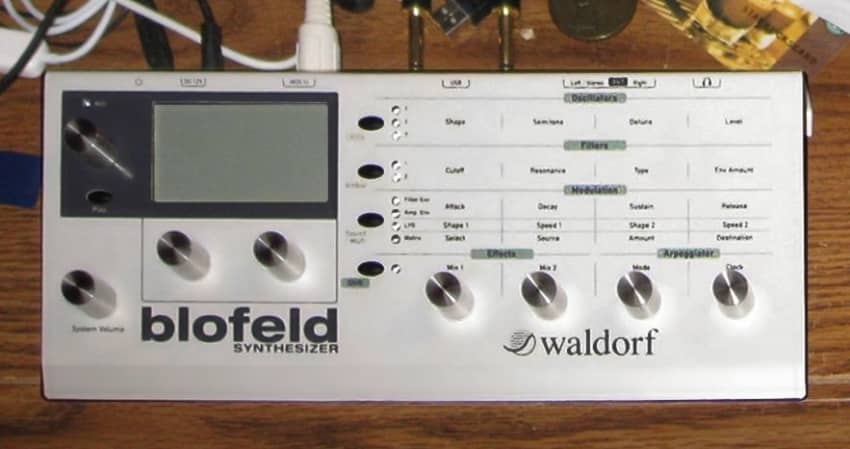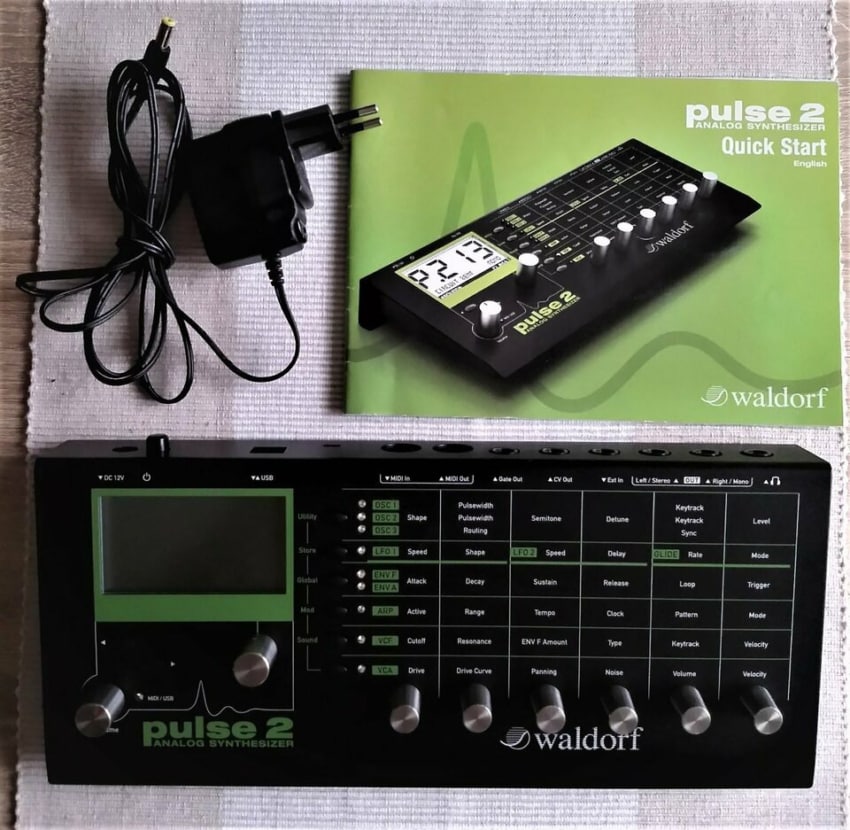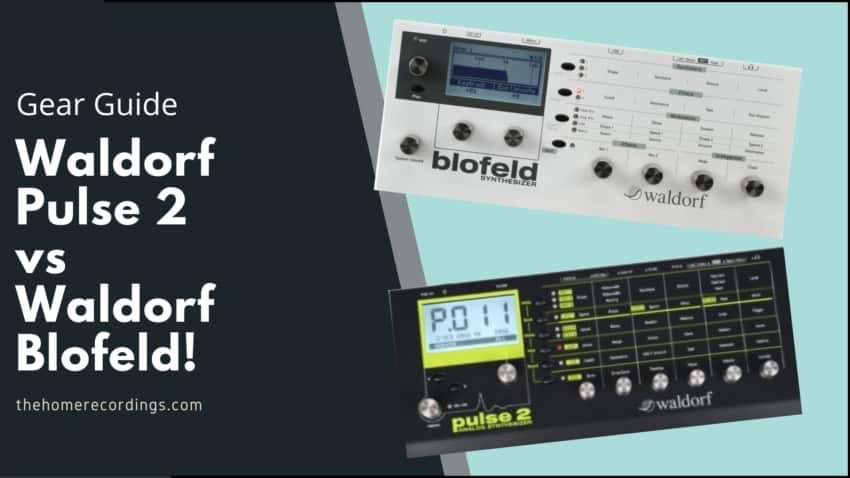Here’s a quick guide for those of you interested in investing in a synthesizer, specifically of the Waldorf variety, as I’ll be dissecting the differences between the Waldorf Pulse 2 and the Waldorf Blofeld.
In short, here are the differences between the Waldorf Pulse 2 and the Waldorf Blofeld: Both synthesizers offer great sound design capabilities, with the main difference between the two being that the Pulse 2 is a monophonic synthesizer with Paraphonic modes, less suited to playing chords, whereas the Blofeld has up to 25 note polyphony.
Waldorf Blofeld

The Blofeld has an incredible sound, combining the pure analog signal with features of the modern age in a polished design. It has a display that makes navigating presets and patches seamless, with 1,000 sounds to play with.
You can sculpt and rework these sounds with the seven provided knobs and five buttons, and also a USB connection.
The Blofeld offers up to 25 voices, 16-part multi-timbral, and three oscillators per voice with many more features that you’ll find in the specifications, but one of my favorite things about the Blofeld is the freely programmable arpeggiator, with up to 16 steps per sound. Some synthesizers lock you into certain patterns, but not the Blofeld.
In my experience, the Blofeld creates some absolutely breathtaking sounds, especially when leaning towards warm pad sounds, but as is the case with all analog gear, the extent of the power is limited by the user.
I’ve only had the fortune of using a Blofeld whilst at the music store, but the staff almost had to tell me to leave because I was messing around with the synthesizer for that long!
Module Features:
- Up to 25 voices
- 16-part multi timbral
- Three oscillators per voice
- Frequency Modulation between the oscillators
- All Q oscillator models
- All microwave II/XT/XTk wavetables
- Two independent Multi Mode filters per voice
- Filter FM
- Two drive stages per voice with selectable drive curves
- Three fast LFOs per voice
- Four fast envelopes per voice
- Powerful arpeggiator
- Freely programmable arpeggiator Pattern with up to 16 steps per sound
- Seven endless stainless steel dials
- Five buttons
- Graphic display (128 x 64 pixels)
- Volume control
What comes in the Box?
- Waldorf Blofeld
- Power supply
Specifications
| Polyphony | 25 notes |
| Presets | 1000+ |
| Arpeggiator | Yes |
| Analog Inputs | N/A |
| Analog Outputs | 2 x TS, 1 X TRS (Headphones) |
| USB | 1 x Type B |
| MIDI I/O | In/USB |
| Dimensions | 2.13″ x 11.97″ x 5.19″ |
Find out more about the Waldorf Blofeld here:
- Waldorf Blofeld: Amazon, Sweetwater.
Waldorf Pulse 2

The Waldorf Pulse 2 is a monophonic analog synthesizer.
A sleek visual design matched by a clever internal structure and plenty of parameters to work with combine to create this awesome, compact piece of hardware.
The Pulse 2 has three analog oscillators and a cascade filter, with highpass and bandpass modes that weren’t included in the original Pulse model.
It also consists of interesting “paraphonic” modes that allow up to 8-voice chords on the otherwise monophonic synthesizer, which allows some experimentation with more than one note at a time, such as playing chords, with those specific sound patches.
The arpeggiator is really intuitive and allows you to add extra rhythm into any patches that you design or presets that you load in, with multiple presets at your disposal.
The Pulse 2 has a really thick and punchy analog sound, whether you’re loading up any of the 400 preset patches or creating your own, you can really tell the difference between this synthesizer and a virtual instrument. It also holds an extra 100 patches to make a total of 500, so you should have plenty of space to experiment.
As my first ever synthesizer, I was delighted with the Pulse 2 because it provides enough freedom to craft your own sounds without completely overwhelming you as a beginner, but also consists of enough firepower for more advanced users to really unleash the Pulse’s potential.
Personally, I think the Pulse 2 is best when creating bass or lead sounds, due to its monophonic nature, which is perfect for adding extra quality to your music production.
Module features:
- Three analog oscillators; one noise generator
- Pulse width modulation; hard sync
- Filter FM and Ring Modulation from Oscillator 3
- XOR Osc mode; 8/4-voice Paraphonic modes
- Cascade Filter, 24dB/12db Lowpass, 12db Highpass/Bandpass filter modes
- Powerful Arpeggiator; 8-slot Modulation Matrix
- External analog signal input
- Backward-compatible with classic Pulse
- 128×64 character backlit LCD screen
- Eight knobs
What comes in the Box?
- Waldorf Pulse 2
- Power supply
Specifications
| Polyphony | Monophonic (with 8/4 Notes Paraphonic Modes) |
| Presets | 1000+ |
| Arpeggiator | Yes |
| Analog Inputs | 2 x 1/4″ |
| Analog Outputs | 1 x 1/4″ |
| USB | 1 x Type B |
| MIDI I/O | In/Out/USB |
| Dimensions | 2.4″ x 12″ x 5.3″ |
Find out more about the Waldorf Pulse 2 here:
- Waldorf Pulse 2: Amazon, Sweetwater.
Main Differences
The biggest difference between the two Waldorf synthesizers is that the Pulse 2 is monophonic, with paraphonic modes, whereas the Blofeld has up to 25 note, true polyphony. This means that the Pulse 2 is incredible at crafting bass sounds or lead sounds, whereas the Blofeld excels at ethereal pads and interesting digital keys.
Conclusion
Both products meet professional standards of build and sound quality, with slightly different options when it comes to crafting your own patches, but the power in both to elevate your music with true analog sounds.
I have had around 4 years of joy using the Pulse 2, and have created hundreds of amazing patches, but due to its monophonic nature, I am now looking for a new synthesizer with true polyphony. So, if you foresee that being an issue for you then definitely consider the Blofeld first.

Hi & Thanks. So is the Blofeld similar to the Streichfett? One goal of the Streichfett is to render a string sound similar to the string sounds of the 1980’s (I am older and I own a Streickett); would the Blofeld fill a more modern niche? I kinda like the Waldorf synthesizer design. I’m interested in your impression of the Blofeld sounds.